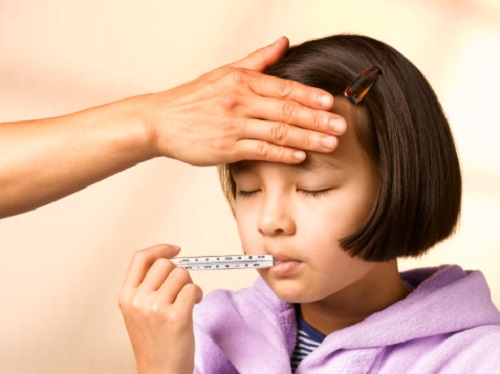Difference between Fever and Hot Flashes
I feel hot! Fever or hot flashes?
One of the vital health signs, key to identify a major issue, is body temperature, humans only survive if the organism is between 36.5 and 38 Celsius degrees (97.7 – 100.4 Fahrenheit). We’ll cover all about normal increases in the body temperature: fever and hot flashes.
Basic concepts:
Menopause is a normal physiological process in women, which implies the end of menstruation. There is also a transition period between the last years of the reproductive stage and post-reproductive life, which begins with the progressive disappearance of ovarian function. (1)
Both the transition period and the full stage of menopause are marked by the gradual decline of estrogen secretion and numerous hormonal alterations, that evolves into a series of organic and psychological changes, which can become so significant that they constitute an important source of disability and discomfort. Within those changes are the common hot flashes. (1)
- Tip: The complete cease of menstruation for twelve months or more is considered menopause, usually occurs between the fifth and sixth decade of life (average age of 52 years). (1)
On the other hand, when we refer to fever, most physicians define it as an oral temperature greater than 38.3 ° C at any time of day, although the temperature trends over time is more useful than a single reading.
For example, the normal body temperature in a healthy adult, it’s considered to be 37 ° C, but that is variable, since the body temperature is lower in the morning (around 6:00 am) and higher in the afternoon (4:00 pm-6: 00 pm). Normally, body temperature also rises in response to certain conditions, such as physical activity and warm weather. The temperature of the body is controlled by the hypothalamus and its regulatory mechanisms keep the body core at a normal level, adjusting between low and high temperature. (5)
But why and how do they happen?
In the case of hot flashes, there is a hormonal imbalance caused by a sudden drop on estrogen levels, the most immediate consequence of the lack of estrogen is on the hypothalamus, and this increases the levels of production of the other female sexual hormones (FSH, LH). At this stage, complex changes occur throughout the endocrine system, but the most important change is in the metabolism of adrenaline, one of the proposed mechanisms for the symptoms of hot flashes.
The decreased levels of sex hormones (estrogen and progesterone) have detrimental effects on other functions, with a significant increase in vaginal dryness, thus pain in the sexual act and a significant decrease in desire and sexual drive. Healthy aging is very important to maintain overall quality of life and sexual well-being. (3)
On the other hand, fever, usually is a response to infection, although high temperatures can also happen in simple inflammation. This reaction is initiated by the effects of external inducing agents (bacteria, pollen, powders, vaccines, proteins or products of disintegration) or by toxins produced by bacteria. These inducing agents stimulate the production of chemical signals, including cells and molecules of the immune system (6). They interact with the hypothalamus, the thermal center of the body, that sends a signal through the autonomic nervous system, to provoke the hormonal and behavioral components of the febrile response: Contraction of blood vessels, secretion of adrenaline, chills resulting in an increase in body temperature, sweating and warming of the skin (6).
Understanding women, a little bit more:
Estrogen has very different effects. In the ovary, they stimulate the synthesis of receptors for follicle stimulating hormone (FSH), that contributes to the development and growth of ovarian follicles. In the uterus, they induce the renewal of the inner skin and the growth of all its layers, favoring the development of glands, blood vessels and all tissue. In the cervix, they cause the mucous glands to produce a mucus with a high-water content, and dilate the canal. In the vagina, the layers proliferate, the vulva becomes turgid and elastic.
On the breasts, they stimulate the proliferation of the glandular ducts, the accumulation of fatty tissue, increase of the pigmentation of the nipples. Estrogen also participate in many metabolic processes, such as water and sodium retention in tissues; they increase blood glucose, raise HDL (good) cholesterol, lower triglycerides. On the vessels, they stimulate the peripheral circulation. In the bones, they stimulate the fixation and mineralization of the bone matrix, promote calcium deposition. Even on the skin, favoring the development of elastic fibers.
Comparing symptoms
Hot flashes are the most characteristic clinical manifestation of the menopause. It is defined as a subjective sensation of heat that rises from the chest to the neck and to the face, usually associated with skin redness and sweating following an increase of body temperature and even acceleration of heart rate. (2) It is normal to suffer hot flashes in the pre-menopausal stage and during the first three years after the definitive cessation of menstruation, then the frequency decreases. Usually hot flashes appear once or twice a day and can last between two and three minutes approximately. (9)
Fever, is very different, it is an objective measure of body temperature that defines the condition. Because it’s a manifestation of any kind of infection or even an inflammatory disease, a universe of symptoms might appear depending on the affected place of the body and the microorganism that is attacking it.
Regarding the treatments…
For hot flashes, the experts point out that there are no generalized programs for all women, but that each case should be analyzed individually and look for the best method. There are currently effective treatments but they only work well when it fits the individual case (9), talk to your doctor about taking hormone therapy in the short term. In many women, this type of treatment prevents hot flashes. In addition, it may help with other symptoms of menopause, including vaginal dryness or mood swings. (8) To prevent hot flashes, avoid the following elements:
- Stress
- Caffeine
- Alcohol
- Spicy foods
- Tight clothing
- Heat
- Smoking cigarettes
Other things you can do to stay away from hot flashes: (8)
- Stay cool. Keep your room cool at night. Uses fans during the day. Wear light clothing and layers.
- Try to breathe deeply and slowly using your abdomen (6 to 8 times / sighs per minute). Practice breathing deeply for 15 minutes in the morning, 15 minutes at night and when hot flashes start.
- Exercise daily. Walking, swimming, dancing and cycling are all very good choices.
The management of fever while defining its cause, is symptomatic. Such management should include application of physical means and the use of antipyretics. The use of broad spectrum antibiotics should be avoided without having taken the laboratory samples because this practice helps to mask important signs and symptoms, and it contributes to the terrifying raise of the antibiotic resistance of bacteria. Fungal infection and in viral diseases also can lead to fever. (10)
Now let’s review the differences
| Fever | Hot flashes |
| It is an increase in body temperature measured orally equal to or greater than 38.3 ° C | Subjective sensation of heat, increase in body temperature |
| It is maintained over time and it compromises the entire body. | They are described as periods of intense heat in the upper half of the trunk, upper limbs and face. |
| It usually occurs as a result of the exposure to infecting microorganisms, immune complex mechanisms or other causes of inflammation. | It happens as a consequence of an estrogen deprivation in menopause |
| It happens at any age. | It occurs between the fifth and sixth decade of life |
| It is often accompanied by chills and coldness. | Chills are less common |
| Treatment is based on the placement of physical means and administration of antipyretics at adequate doses, as well as the recognition of a possible infection and the identification of the microorganism | Hormone therapy in the short term in many Women prevent hot flashes. In addition, it may help with other symptoms of menopause, including vaginal dryness or mood swings
|
- Difference between Fever and Hot Flashes - August 4, 2017
- Difference Between PAD and PVD - June 9, 2017
- Difference Between Melanoma and Carcinoma - May 31, 2017
Search DifferenceBetween.net :
Leave a Response
References :
[0]Colombiana de Salud. http://www.colombianadesalud.org.co/GUIAS_MEDICINA_ESPECIALIZADA/GUIAS%20CONSULTA%20ESPECIALIZADA/GINECOOBSTETRICIA/09%20MENOPAUSIA.pdf (1)
[1]Vasomotor symptoms of climacteric women. Peruvian Journal of Gynecology and Obstetrics. http://scielo.sld.cu/scielo.php?script=sci_arttext&pid=S0138-600X2011000400014(2)
[2]Colombian Menopausal magazine http://www.asomenopausia.com/r/22_4.pdf (3)
[3]Peruvian Journal of Gynecology and Obstetrics. http://www.spog.org.pe/web/revista/index.php/RPGO/article/viewFile/1092/pdf_115 (4)
[4]Journal of the Faculty of Medicine of the UNAM. Mexico http://www.medigraphic.com/pdfs/facmed/un-2014/un144d.pdf (5)
[5]Cuban Journal Military Medicine http://bvs.sld.cu/revistas/mil/vol28_1_99/mil08199.pdf (6)
[6]University Medical Journal. Faculty of Medical Sciences. National University of Cuyo. http://bdigital.uncu.edu.ar/objetos_digitales/1241/sayeghrmuv1n1.pdf (7)
[7]Menopause and hot flashes. Cleveland Clinic Health Information Center. http://www.clevelandclinic.org/health/sHIC/doc/s10087.pdf (8)
[8]PULEVASALUD. http://www.pulevasalud.com/ps/revista/2010/06/28_pulevasalud_junio_2010.pdf (9)
[9]Febrile syndrome. Hospital Santa Margarita http://santamargarita.gov.co/intranet/pdf/E.S.E/FIEBRE.pdf (10)
[10]http://mbahdukunbagong.blogspot.in/2010/09/fever-is-body-temperature-rise-above.html
[11]http://www.magforwomen.com/3-causes-of-hot-flashes-in-women/


